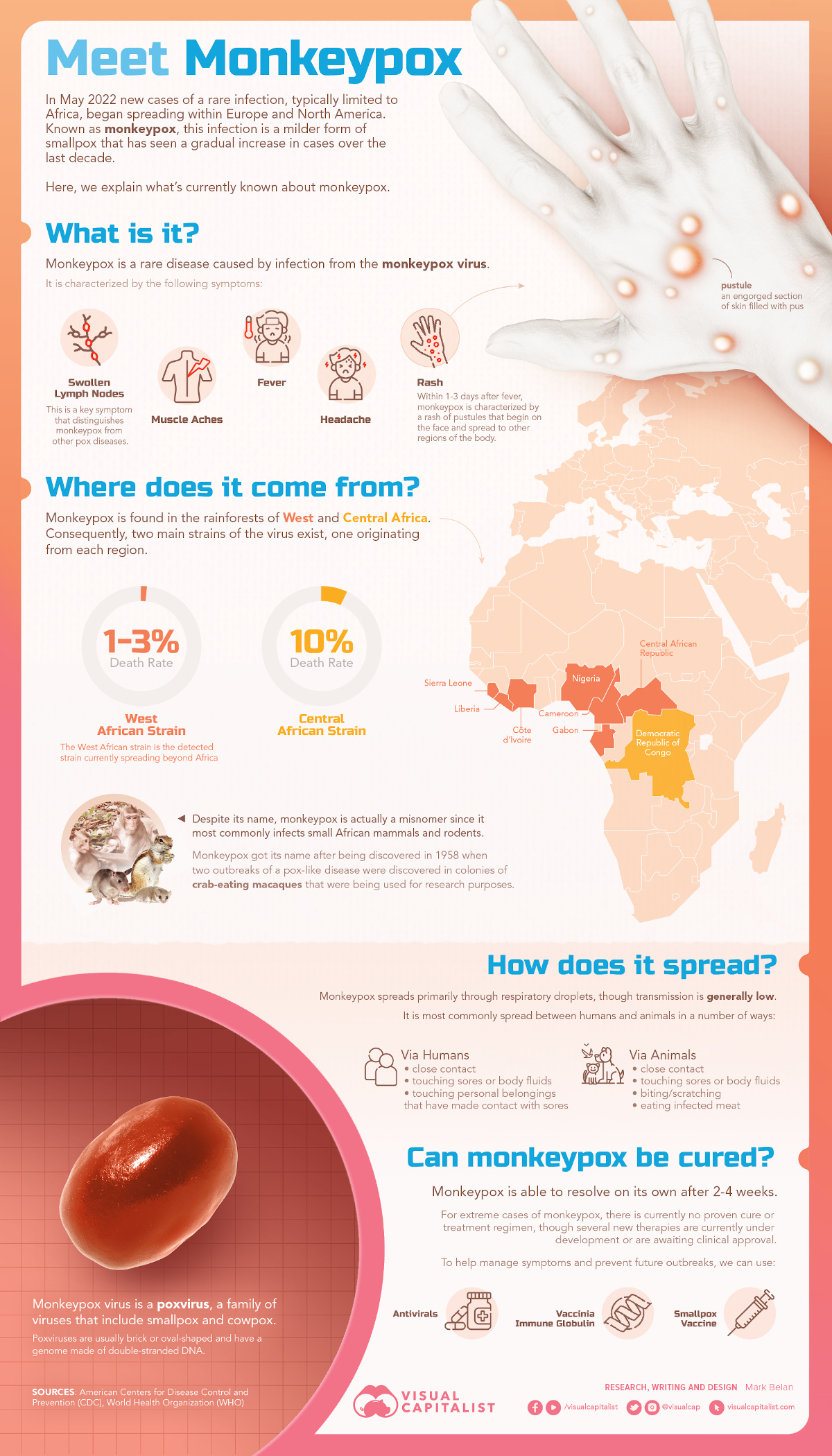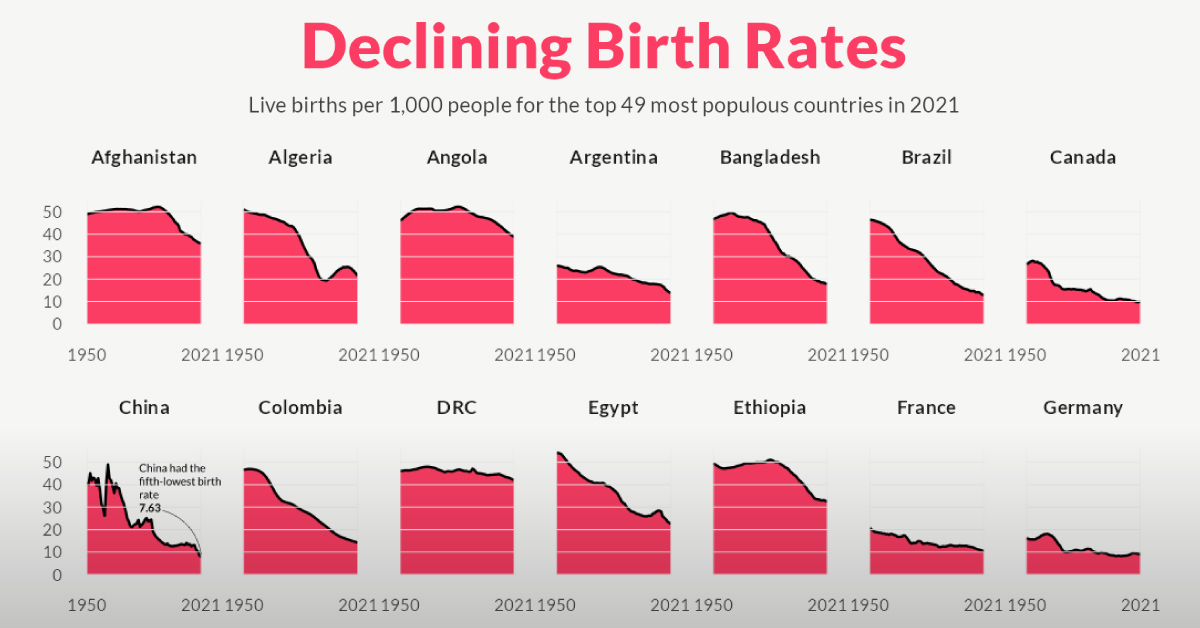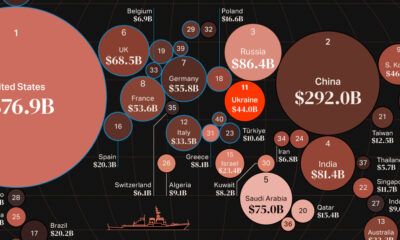Healthcare
Explainer: What to Know About Monkeypox

Explainer: What to Know About Monkeypox
The COVID-19 pandemic is still fresh in the minds of the people around the world, so it comes as no surprise that recent outbreaks of another virus are grabbing headlines.
Monkeypox outbreaks have now been reported in multiple countries, and it has scientists paying close attention. For everyone else, numerous questions come to the surface:
- How serious is this virus?
- How contagious is it?
- Could monkeypox develop into a new pandemic?
Below, we answer these questions and more.
What is Monkeypox?
Monkeypox is a virus in the Orthopoxvirus genus which also includes the variola virus (which causes smallpox) and the cowpox virus. The primary symptoms include fever, swollen lymph nodes, and a distinctive bumpy rash.
There are two major strains of the virus that pose very different risks:
- Congo Basin strain: 1 in 10 people infected with this strain have died
- West African strain: Approximately 1 in 100 people infected with this strain died
At the moment, health authorities in the UK have indicated they’re seeing the milder strain in patients there.
Where did Monkeypox Originate From?
The virus was originally discovered in the Democratic Republic of Congo in monkeys kept for research purposes (hence the name). Eventually, the virus made the jump to humans more than a decade after its discovery in 1958.
It is widely assumed that vaccination against another similar virus, smallpox, helped keep monkeypox outbreaks from occurring in human populations. Ironically, the successful eradication of smallpox, and eventual winding down of that vaccine program, has opened the door to a new viral threat. There is now a growing population of people who no longer have immunity against the virus.
Now that travel restrictions are lifting in many parts of the world, viruses are now able to hop between nations again. As of the publishing of this article, a handful of cases have now been reported in the U.S., Canada, the UK, and a number of European countries.
On the upside, contact tracing has helped authorities piece together the transmission of the virus. While cases are rare in Europe and North America, it is considered endemic in parts of West Africa. For example, the World Health Organization reports that Nigeria has experienced over 550 reported monkeypox cases from 2017 to today. The current UK outbreak originated from an individual who returned from a trip to Nigeria.
Could Monkeypox become a new pandemic?
Monkeypox, which primarily spreads through animal-to-human interaction, is not known to spread easily between humans. Most individuals infected with monkeypox pass the virus to between zero and one person, so outbreaks typically fizzle out. For this reason, the fact that outbreaks are occurring in several countries simultaneously is concerning for health authorities and organizations that monitor viral transmission. Experts are entertaining the possibility that the virus’ rate of transmission has increased.
Images of people covered in monkeypox lesions are shocking, and people are understandably concerned by this virus, but the good news is that members of the general public have little to fear at this stage.
I think the risk to the general public at this point, from the information we have, is very, very low.
–Tom Inglesby, Director, Johns Hopkins Center for Health Security
» For up-to-date information on monkeypox cases, check out Global.Health’s tracking spreadsheet
Demographics
Charted: The Rapid Decline of Global Birth Rates
For the last 70 years, birth rates for the 49 most populous countries of the world have fallen sharply, heralding an uncertain future.

Charted: The Rapid Decline in Global Birth Rates
In 1798, British economist Thomas Malthus proposed a groundbreaking theory now known as the “Malthusian Trap”—suggesting that human population growth is exponential and thus would outpace the linear growth of resources such as food supply.
He worried that this runaway population growth would become unsustainable, eventually relying on sudden shock events—wars, disasters, famines—to reset the population to more sustainable levels. And over the next 200 years, the world population skyrocketed from 1 billion to 8 billion people on the planet.
However, as it turns out, no such shock events were required to turn the tide of population growth. Instead, it’s been rapidly declining birth rates across the world that seem to be leading to an unthinkable outcome for Malthus: a gradually plateauing or even shrinking global population.
In the visualization above, Pablo Alvarez has visualized the crude birth rate for the 49 most populous countries of the world in 2021, using data from the UN’s World Population Prospects 2022 to examine changes since 1950.
Understanding Birth Rates vs Fertility Rates
Birth rates are commonly measured using a metric called the “crude birth rate” (CBR), which represents the number of live births per 1,000 individuals in a given population during a specific period—usually one year.
The measured decline in CBR is also a result of plummeting fertility rates across the globe. Not to be confused with birth rates, fertility rates measure how many children a woman will have over the course of her lifetime.
While a country’s birth rate is directly impacted by the fertility rate, it also takes into account other factors: population size, age structure of the population, access to contraception, cultural norms, government policies, and socioeconomic conditions.
Birth Rates of the Most Populated Countries
Here’s a snapshot of the CBR for the 49 most populous countries of the world at different years from 1950 to 2021.
| Country | 1950 | 1990 | 2021 | % Change (1950-2021) |
|---|---|---|---|---|
| 🇦🇫 Afghanistan | 48.87 | 51.42 | 35.84 | -27% |
| 🇩🇿 Algeria | 51.05 | 30.76 | 21.52 | -58% |
| 🇦🇴 Angola | 46.15 | 51.34 | 38.81 | -16% |
| 🇦🇷 Argentina | 26.00 | 21.99 | 13.90 | -47% |
| 🇧🇩 Bangladesh | 46.52 | 34.97 | 17.82 | -62% |
| 🇧🇷 Brazil | 46.43 | 24.84 | 12.88 | -72% |
| 🇨🇦 Canada | 26.80 | 15.46 | 9.82 | -63% |
| 🇨🇳 China | 41.05 | 24.44 | 7.63 | -81% |
| 🇨🇴 Colombia | 46.74 | 27.37 | 14.20 | -70% |
| 🇨🇩 DRC | 46.02 | 46.01 | 42.05 | -9% |
| 🇪🇬 Egypt | 54.20 | 33.21 | 22.56 | -58% |
| 🇪🇹 Ethiopia | 49.40 | 50.05 | 32.38 | -34% |
| 🇫🇷 France | 20.77 | 13.34 | 10.50 | -49% |
| 🇩🇪 Germany | 16.22 | 11.30 | 9.17 | -43% |
| 🇬🇭 Ghana | 46.76 | 40.37 | 27.55 | -41% |
| 🇮🇳 India | 43.84 | 31.82 | 16.42 | -63% |
| 🇮🇩 Indonesia | 40.64 | 25.52 | 16.42 | -60% |
| 🇮🇷 Iran | 50.14 | 32.46 | 13.70 | -73% |
| 🇮🇶 Iraq | 45.73 | 39.41 | 27.37 | -40% |
| 🇮🇹 Italy | 19.70 | 10.01 | 6.93 | -65% |
| 🇯🇵 Japan | 28.34 | 9.91 | 6.57 | -77% |
| 🇰🇪 Kenya | 49.47 | 43.52 | 27.68 | -44% |
| 🇲🇾 Malaysia | 44.31 | 27.89 | 15.24 | -66% |
| 🇲🇽 Mexico | 49.31 | 29.30 | 14.86 | -70% |
| 🇲🇦 Morocco | 51.08 | 29.23 | 17.55 | -66% |
| 🇲🇿 Mozambique | 46.66 | 46.38 | 36.60 | -22% |
| 🇲🇲 Myanmar | 45.58 | 27.48 | 17.10 | -62% |
| 🇳🇵 Nepal | 47.06 | 38.11 | 20.40 | -57% |
| 🇳🇬 Nigeria | 45.61 | 43.79 | 37.12 | -19% |
| 🇵🇰 Pakistan | 43.72 | 43.15 | 27.52 | -37% |
| 🇵🇪 Peru | 48.16 | 30.90 | 17.62 | -63% |
| 🇵🇭 Philippines | 49.84 | 33.26 | 21.81 | -56% |
| 🇵🇱 Poland | 30.85 | 14.28 | 9.49 | -69% |
| 🇷🇺 Russia | 28.80 | 13.52 | 9.64 | -67% |
| 🇸🇦 Saudi Arabia | 53.34 | 34.41 | 17.47 | -67% |
| 🇿🇦 South Africa | 41.65 | 31.15 | 19.82 | -52% |
| 🇰🇷 South Korea | 40.03 | 15.69 | 5.58 | -86% |
| 🇪🇸 Spain | 20.01 | 10.30 | 7.55 | -62% |
| 🇸🇩 Sudan | 47.75 | 43.09 | 33.60 | -30% |
| 🇹🇿 Tanzania | 47.75 | 43.78 | 36.21 | -24% |
| 🇹🇭 Thailand | 43.84 | 19.73 | 9.00 | -79% |
| 🇹🇷 Türkiye | 46.39 | 25.87 | 14.68 | -68% |
| 🇺🇸 U.S. | 22.81 | 16.73 | 11.06 | -52% |
| 🇺🇬 Uganda | 52.42 | 51.37 | 36.80 | -30% |
| 🇬🇧 UK | 16.44 | 13.88 | 10.08 | -39% |
| 🇺🇦 Ukraine | 22.95 | 12.76 | 7.72 | -66% |
| 🇺🇿 Uzbekistan | 39.85 | 33.98 | 23.55 | -41% |
| 🇻🇳 Vietnam | 38.82 | 28.51 | 15.01 | -61% |
| 🇾🇪 Yemen | 52.59 | 50.64 | 30.54 | -42% |
Every country on the list has seen a decline in birth rates in the last 70 years, with some declines more staggering than others. For example, China recorded 41 births per 1,000 people in 1950. By 2021, that number had fallen to just 7.6, a 81% decrease.
South Korea, the 29th most populous country in the world in 2021, saw an even larger 86% drop in its birth rate since 1950. In fact, almost every single country in this dataset has seen a double-digit fall in their birth rates over the past 70 years. Only the Democratic Republic of Congo has seen a single-digit percentage decline between 1950 and 2021.
Why are Global Birth Rates Falling?
For the 49 most populated countries in 2021, birth rates have halved on average in the last 70 years:
| 49 Most Populated Countries | 1950 | 1990 | 2021 |
|---|---|---|---|
| Average Birth Rate | 40.99 | 30.18 | 19.50 |
| Median Birth Rate | 45.73 | 30.76 | 17.10 |
But while the thought of a shrinking world population may seem worrisome, declining birth rates are generally thought of as a triumph of rapid socio-economic development.
As countries progress and living standards improve, there is a shift in societal norms and aspirations. For example, expanded education and career opportunities for women allow the pursuit of professional growth and personal goals, with some women choosing to delay starting a family or having smaller families.
Growing urbanization is another key driver of declining birth rates, characterized by smaller living spaces, increased focus on careers, and limited support networks. Another is the growing access to family planning services and contraceptives, particularly since the 1970s.
What are the Future Consequences?
The biggest consequence of declining birth rates—and one that is already being seen in many parts of the world—is a rapidly aging population.
With fewer children being born, the proportion of elderly individuals increases relative to the working-age population. This demographic imbalance poses challenges for social welfare systems, healthcare, and pension schemes.
Declining birth rates can also impact the labor market and economic productivity. A smaller workforce may lead to labor shortages, skill gaps, and reduced innovation. And shrinking populations reduce consumer demand, a cornerstone of the global economy, which may trigger a restructure of the current growth model of development.
-

 Cities1 week ago
Cities1 week agoMapped: The Most Dangerous Cities in the U.S.
-

 Energy3 weeks ago
Energy3 weeks agoHow Old Are the World’s Nuclear Reactors?
-

 Countries7 days ago
Countries7 days agoMapped: World’s Top 40 Largest Military Budgets
-

 Energy3 weeks ago
Energy3 weeks agoHow Big is the Market for Crude Oil?
-

 United States6 days ago
United States6 days agoMapped: The Safest Cities in the U.S.
-

 Markets2 weeks ago
Markets2 weeks agoRanked: The Most Profitable U.S. Companies, by Sector
-

 Technology5 days ago
Technology5 days agoHow Long it Took for Popular Apps to Reach 100 Million Users
-

 Markets4 weeks ago
Markets4 weeks agoThe World’s Biggest Mutual Fund and ETF Providers










 Creator Program
Creator Program
